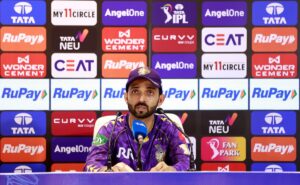
Rohit Sharma Finally Reveals Why He Yelled 'Koi Garden Mein Nahi Ghoomega' | Inside Story Behind Viral Cricket Moment
Rohit Sharma Finally Reveals Why He Yelled ‘Koi Garden Mein Nahi Ghoomega’
Table of Contents
- The Viral Cricket Moment That Took Social Media By Storm
- The Context: India vs England Test Match in Visakhapatnam
- Rohit Sharma’s Explanation: “Players Were Leisurely Walking”
- Leadership Under Pressure: Why Intensity Matters in Test Cricket
- From Stump Mic to Social Media: How Cricket Comments Go Viral
- Rohit’s Current IPL Form: Struggling to Find His Rhythm
- Sehwag’s Criticism: Time to Protect the Legacy?
- Leadership Traits: What Makes Rohit Sharma Unique as Captain
The Viral Cricket Moment That Took Social Media By Storm
Indian cricket captain Rohit Sharma has finally shed light on one of the most viral cricket moments of 2024 – his animated “Koi garden mein nahi ghoomega” (Nobody will stroll around as if in a garden) comment that was picked up by stump microphones during a Test match against England. The passionate outburst quickly became a sensation across social media platforms, with fans creating countless memes and videos featuring Rohit’s commanding words.
The remark, which perfectly encapsulates Rohit’s no-nonsense leadership style, resonated with cricket enthusiasts who appreciated the captain’s demand for intensity and urgency on the field. Until now, however, the exact circumstances that prompted this outburst remained unknown to the public.
The Power of Stump Mic Moments
Stump microphones have given cricket fans unprecedented access to on-field conversations, tactical discussions, and emotional moments during matches. Comments like Rohit’s “Koi garden mein nahi ghoomega” often provide genuine glimpses into a captain’s leadership style and team dynamics that formal press conferences rarely reveal. These unfiltered moments tend to connect more authentically with fans, explaining why they frequently go viral.
The Context: India vs England Test Match in Visakhapatnam
The incident occurred during the second Test match between India and England in Visakhapatnam in February 2024. This was a crucial game in the series, with India under pressure to perform after facing challenges in the opening match. The context was a critical phase of the contest, with the match hanging in the balance and India desperately needing to break a partnership.
Played under hot and humid conditions at the ACA-VDCA Cricket Stadium, the match required exceptional concentration and energy from the fielding side. India had spinners operating from both ends, with Rohit positioned in the slips—giving him a perfect vantage point to observe the overall field placements and energy levels of his teammates.
“It was in Vizag, I saw the over ended and the players were leisurely walking as if they were in a garden. No one was running, there was no urgency in the field.”
Rohit Sharma’s Explanation: “Players Were Leisurely Walking”
Speaking on JioHotstar recently, Rohit explained that his frustration stemmed from observing his teammates’ casual approach during a critical phase of the match. “I saw the over ended and the players were leisurely walking as if they were in a garden. No one was running, there was no urgency in the field,” he revealed.
The Indian skipper emphasized that he had specifically addressed the team that morning about the need for extra effort. “I had told the players in the morning that we need to put in some extra effort but they were having fun in the ground,” Rohit added, highlighting the disconnect between his pre-match instructions and the execution he was witnessing on the field.
After observing this relaxed approach for two to three overs, Rohit’s patience finally ran out. “So I saw it for two-three overs and then said things can’t go on like this, you can’t play cricket like this. Everyone was just going with the flow which annoyed me and then I told everyone not to be like that,” he explained.
Captain’s Breaking Point
“A partnership was going on, I was desperate to get a wicket. In such moments everyone needs to put in a collective effort. At that moment, I saw everyone being busy with themselves which I didn’t like,” Rohit elaborated, providing insight into the high-stakes situation that triggered his now-famous outburst.
Leadership Under Pressure: Why Intensity Matters in Test Cricket
Rohit’s reaction illustrates the importance of maintaining intensity throughout the five days of a Test match—especially in critical phases when breakthroughs are needed. In the longer format of cricket, matches can often be decided by brief periods of exceptional concentration and effort, making field placement and alertness crucial components of success.
As captain, Rohit understands that creating and sustaining pressure on opposition batsmen requires coordinated team effort. This includes quick turnarounds between overs, strategic field placements, and constant communication—all aspects that suffer when players adopt a casual approach on the field.
The incident provides a window into Rohit’s leadership philosophy, which emphasizes collective responsibility and maintaining high energy levels even when results aren’t immediately forthcoming. In Test cricket, where patience and persistence are essential virtues, ensuring that the team maintains intensity through challenging periods can make the difference between victory and defeat.
From Stump Mic to Social Media: How Cricket Comments Go Viral
The “garden” comment quickly transcended the cricket field to become a cultural reference point for fans. Within hours of being broadcast, the clip had been shared thousands of times across platforms like X (formerly Twitter), Instagram, and YouTube, often accompanied by creative memes and remixes.
Part of what made this particular comment resonate was its relatability—the phrase perfectly encapsulated a sentiment familiar to anyone who has played team sports at any level. The authenticity of the moment, captured in the heat of competition, connected with viewers in a way that scripted content rarely achieves.
Digital Cricket Culture
The viral nature of stump mic comments has created a new dimension to cricket fandom, where memorable phrases become part of cricket lexicon. From MS Dhoni’s field placement instructions to Virat Kohli’s animated celebrations, these unscripted moments now form a significant part of cricket’s digital culture—creating connections between players and fans that extend beyond the formal boundaries of the sport.
Rohit’s Current IPL Form: Struggling to Find His Rhythm
While Rohit’s leadership credentials in international cricket remain strong, his current form in the IPL 2025 has become a subject of concern. The revelation about his famous comment comes at a time when the veteran batter is experiencing a challenging season with Mumbai Indians.
In the recent match against Sunrisers Hyderabad, Rohit was brought in as an Impact Player by current MI skipper Hardik Pandya—a tactical move that highlights his fluctuating role in the team. Despite the opportunity, he managed only 26 runs before falling to Australian paceman Pat Cummins.
The statistics paint a worrying picture of Rohit’s IPL season so far: just 82 runs in six innings at a disappointing average of 13.66. This represents a significant drop from the standards he has set throughout his illustrious career, raising questions about his role and future in the T20 format.
| IPL 2025 Performance | Statistics |
|---|---|
| Innings | 6 |
| Runs Scored | 82 |
| Batting Average | 13.66 |
| Highest Score | 26 |
Sehwag’s Criticism: Time to Protect the Legacy?
Former India opener Virender Sehwag has been particularly critical of Rohit’s IPL performances, suggesting that the time may have come for the former MI captain to reconsider his participation in the format. Sehwag, known for his straightforward opinions, has advised Rohit to protect his legacy—implying that continuing to struggle in the IPL might diminish the achievements of his outstanding international career.
Such criticism from a respected figure like Sehwag adds another dimension to Rohit’s current challenges. As a player who has successfully transitioned his game across formats and phases of his career, Rohit now faces questions about whether T20 cricket still suits his evolving batting style.
The contrast between his commanding presence as India’s Test and ODI captain and his current IPL struggles presents an interesting paradox that Rohit will need to navigate carefully in the coming months.
Leadership Traits: What Makes Rohit Sharma Unique as Captain
The “garden” comment, now explained in Rohit’s own words, offers valuable insight into what makes him effective as India’s captain. His ability to demand excellence while maintaining relationships with players has become a hallmark of his leadership style.
Unlike some captains who lead primarily through personal example, Rohit’s approach incorporates clear communication of expectations, strategic thinking, and the willingness to confront complacency when necessary. His explanation reveals a leader who understands that sometimes, pointed feedback is essential for maintaining the standards required for success at the highest level.
The Captain’s Philosophy
Whether through animated on-field instructions or carefully planned strategy sessions, Rohit Sharma’s captaincy philosophy centers on collective responsibility and maintaining intensity throughout a match. His “Koi garden mein nahi ghoomega” moment perfectly encapsulates this approach—reminding players and fans alike that at the highest level of cricket, momentary lapses in concentration or effort can be the difference between victory and defeat.
As Rohit continues to lead India in Test and ODI cricket while navigating his role in T20s, the lessons from Visakhapatnam remain relevant. In international cricket’s pressure-cooker environment, his insistence on intensity and collective effort—so vividly captured in that viral moment—will continue to define his captaincy legacy regardless of his current IPL form.






